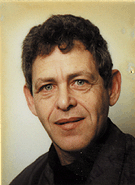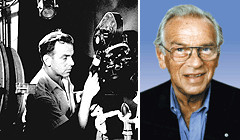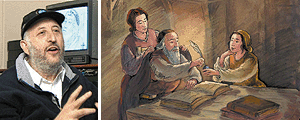Tsvika Oren speaks with three prominent Israeli animators and gives us an overview of Israel's current animated state.

Noam Meshulam
As the story goes, several episodes of Nickelodeon's '97 Sniz & Fondue series were actually broadcast from the Middle East. One can safely assume that all involved were too busy being panicked to make any PR use of the story. The story begins with the Anima Studio in Tel Aviv signing a contract to supply animation services for 13 episodes of the series. Running into difficulties, there was a delay in production and finally the studio closed down. Noam Meshulam, head of Pitchi Poy Studio, in Jaffa, came to the rescue, gathering a team of 60 for nonstop work to redo the first episodes. Completing each episode dangerously near airing time, Meshulam had to drive daringly with the only copy to the main sattelite transmitter antenna, Eitanim, way up on top of a mountain near Jerusalem. Somehow he made it on time for all 13 episodes.

According to Meshulam it was a calculated risk. Financially, he knew, he would at best break even, most likely ending up in the red. Still, pulling it off against all odds would be extremely valuable for the studio's reputation. In addition, working internationally has been every Israeli studio's dream. These reasons justified the tremendous effort -- wild drives up narrow mountainous roads on stormy nights included!
"It proved to be an important step toward our getting into the international animation market," reflects Noam Meshulam. "An arduous process which takes years of marketing your studio, initiating projects, constantly supplying proof of your creativity and recent achievements at important markets such as MIP... Thus, inch by inch, you get in and become recognized, so that when you have a good project to offer you can gain access to the right people".

Noam Meshulam studied animation at Gobelins in Paris, under the late Pierre Ayma. After graduating in 1985 he opened a small studio in his father's house in old Jaffa; a beautiful structure which was built in the 19th century and designed to serve as the Italian embassy to the Ottoman Empire. Careful interior changes were made to adapt it to the needs of the major animation studio it now houses. With a core staff of 15 and dozens of experienced artists joining in when there is need, Pitchi Poy Studio is, at long last, treading on solid ground.
The studio is now busy with Israel's 13-minute episode of the international Animated Tales of the World series, entitled "King Solomon." Recently they completed the 26-minute TV special Children of Chelm, a Canada-Israel co-production likely to be developed into a series.

Pitchi Poy's many projects include the developing of two pilots. One is a co-production with TelAd TV and the other is Dumplings in Space, an international series, which is scheduled to start production in September. And, naturally, commercials. "Commercials are the main source of income for an animation house here," says Meshulam. "The budget per second is usually $1,000 to $2,000.When animation and backgrounds are limited it can drop down to $500. A studio can manage with such budgets. The problem is one can't count on a regular flow of commercials. That's what makes series work so important. It's a studio's bread and butter."
Hanan Kaminski
Director Hanan Kaminski of the TV Loonland studio, Budapest, regards commercials with more enthusiasm. "It is the only kind of commissioned work allowing creative adventures. It often gives me an opportunity to work with the most advanced, most expensive talent and equipment. Luckily, I enjoy the pressure. The sleepless nights. The outrageous last minute changes. By paying me a lot of money they get the right to apply mild torture," explains Kaminski.

Nowadays Kaminski can allow himself this light-hearted attitude toward the hardships of making animated commercials in Israel. He enjoys the unique position of being a successful international feature animation director. Living in Tel Aviv, he travels to work on commercial flights. His two features, The Real Sclemiel (1995) and Pettson & Findus (1999), were made in Hungary, Sweden, Belgium, Canada, Estonia and Bulgaria. Recently added to his flight route is the U.K., where he is working with legendary TVC, London-based producer John Coates (Yellow Submarine) on The Fantastic Flying Journey series.
Hanan Albert Kaminski was born and raised in Belgium, where he joined a socialist Zionist youth movement and moved to a kibbutz in Israel when he turned 18. Graduating Bezalel Academy of Art & Design with a degree from the graphic design department in 1977, he then went to work for IBA national TV. He then received his post-graduate in animation at the Royal Academy, Amsterdam, in 1980. Opening a studio in Jerusalem, he employed up to 10 artists doing commercials, Sesame Street segments, TV spots, etc. Later, after moving the studio to Tel Aviv, he pioneered the trend of kids straight to video in Israel by producing musical variety shows by mixing animation and live-action. Over one million copies of these shows have been sold to date.
"In 1985 I started developing a script based on Bashevis-Zinger's stories of Chelm, the town of fools," recounts Kaminski. "In '93 I closed down the studio, put a few drawings I did for Chelm in a big cardboard file and went to do the rounds in Europe, in search of partners and backing for a Chelm feature. What happened next was quite a Cinderella story. In contrast to the sceptic, at times mean, response the project got in Israel, Europe seemed to be eagerly awaiting my arrival. With generous budgets and enthusiastic professionals we got into production and ended up building a studio in Budapest, employing 100 to 300 artists in a Germany-France-Hungary production. Completing the 77 minute feature in '95, the studio was already busy with another feature and a lot of commissioned work."
In '96 Kaminski was invited to co-direct, with veteran director-illustrator Yossi Abolafya, the new animation unit at Bezalel Academy, Jerusalem. Teaching in Israel while working internationally gives Kaminski a special observation post over Israeli animation: "Israel is overflowing with talent. Many creative people are keen on getting into animation. Quite many innovative young artists are testing Internet and computer possibilities. The main obstacle they all face is that of immature -- animation wise -- clients and commissioning editors. With more knowledgable ones who understand the medium there is no telling how far Iaraeli animation artists will get." This explains Kaminski's plans to do his next feature, now in development, in Israel.

Yoram Gross
It will not be the first animated feature to be made in Israel however. Yoram Gross, now head of a busy studio in Australia where he has made 14 full-length features and 8 television series to date, made the biblical puppet feature Joseph the Dreamer in 1961-62. His studio in Tel Aviv, established in the early '50s, was the first animation house in Israel, although films were first shot in Israel in 1897, when in April of that year, the notorious Lumiere brothers visited from France.

Still, the film industry in Israel was very limited until 1970, when Educational TV and IBA national TV started influencing the local scene. The most dramatic TV influence came after commercial and cable TV started operating in 1993. It gave quite a push to computer graphics, including animation and special effects, as well as video productions. As a result, the last film lab in Israel closed down in 1996. Post-production houses, such as Gravity, which completed Raoul Servais' Taxandria, Broadcast and JCS, all in Tel Aviv, became a central creative force, each developing a strong animation unit relying on Silicon Graphics and Mac computers with the most advanced software. The demand for animation talent has been steadily growing in the last decade. The production of educational CD-Roms, games, multimedia and to supply various Internet needs is on the increase. Tel Aviv's multimedia and software house Disk-In even opened an animation unit when Dudu Shalita closed down Anima Studio and offered his services. They now do international co-productions of TV specials and series, in addition to commercials.
There are three art schools which could be considered the major suppliers of trained talent: Bezalel, Jerusalem; WIZO, Haifa; and Camera Obscura, Tel Aviv. The latter is in a rather peculiar situation. Its Digital Media department offers a 4 year animation program. Yet second year students already get tempting job offers from the industry.

Thirty years ago the only animation training available in Israel was a six month course offered by the late TV Arts College in Tel Aviv. It was a private body taking commercial advantage of the void. Only two of its hundreds of students became professional animators. Then, most of the young animation industry consisted of self taught artists. Prominent among these was, and still is, Roni Oren, director of the Claytoons Studio in Binyamina. Admired as an excellent plasticine animator, he has managed for years to create, almost by himself, at least an hour of full character animation every year. His work consists of many commercials and TV specials, as well as four TV series. The latest of which, Grabbit the Rabbit, is a 13 X 8 minute series co-produced with IBA TV. The series premiered last month and has already been bought by more than 20 TV stations worldwide, from Channel 4 in the U.K. and Fox Kids France to Asia TV Hong Kong and Transworld Association, Japan.

His professional track record includes his own studio in Jerusalem, where top international artist Gil Alkabetz started his career in '84. He has had two other studios since. One was for a Danish company owned by a U.K. businessman and the other was in California (1988), doing commercials and TV specials. What he is most excited about now is: "The possibilities offered by easily available electronic means are mindblowing," says Oren. "I am working now with two Bezalel graduates who every day are doing a 15 to 30 second Flash animation for a commercial Website. Every day a new film! And it is done while we work on a second episode of a cartoon series, do commercials and develope new projects. The creative independence and efficiency offered by computers makes it possible. We are using Crater's CTP and DPS' Reality/Velocity cards, easily getting a lot of good work done fast in broadcast quality. And this is only the beginning of dynamic computer visuals development, with the Internet still in diapers. True, it is now a hungry monster swallowing everything; not able to discern between good and bad [and with] lots of vulgar, stupid or sloppy stuff. Yet, I expect it will not take long to mature into sophisticated work taking advantage of its unique limitations to create exciting new ways of expression."
Another kind of new technology is about to hit Israel -- sattelite TV is due to start operating soon, already influencing TV programming. Israel is about to get exposed to new channels, including Cartoon Network and Fox Kids, with the latter using Saban International's library. In a way bringing Haim Saban's empire in closer contact with the local scene. "There are no plans yet to get into production in Israel," says Varda Saban of the Israel branch. "Our production facilities are well established and very satisfactory. The only involvment we have with Israeli productions is when we do here promos, merchandizing commercials or sell rights of a property of ours." They may have second thoughts. A delegation of top executives from a giant U.S. corporation has been in Israel in August, checking possibilities. Optimists and dreamers alike will be glad to assure anyone of plenty of promising possibilities in the Promised Land.
Tsvika Oren is a veteran animator, film critic, lecturer and animation missionary. He is also Director of The Animation Center in Tel Aviv and the International Creative Filmmaking festival.







